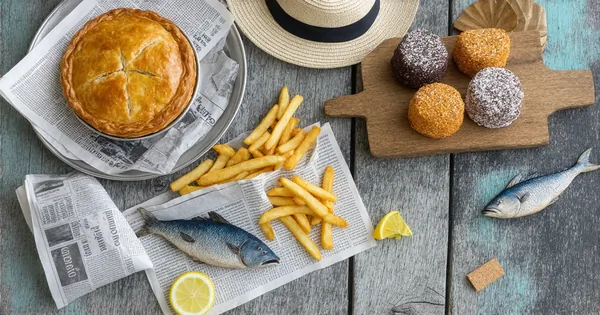
Australia
Navigate Australia's vibrant food scene with our expert guide. Discover authentic Australian cuisine from Sydney's seafood markets to Melbourne's coffee culture, experiencing world-class quality and culinary excellence.
The cuisine of Oceania is a story told by the vast Pacific Ocean, a narrative of island sustenance, ancient navigation, and modern fusion. It's a region where food is deeply connected to land and sea, from the slow-cooked feasts of Polynesian earth ovens to the vibrant, globally-influenced cafés of Australia. To eat here is to taste the legacy of the world's greatest navigators and the fresh-forward thinking of contemporary chefs.
Across Polynesia and Melanesia, the earth oven ("Hāngi" in New Zealand, "Lovo" in Fiji, "‘Umu" in Samoa) is a cornerstone of communal life. This ancient method involves slow-cooking food over pre-heated rocks in a pit, infusing everything with a unique earthy, smoky flavor. It represents a deep cultural value of community, patience, and celebration.
The core of traditional Pacific Island cuisine is built on starchy root vegetables like taro, yams, and kumara, alongside breadfruit—all transported across the ocean by early navigators. Coconut is the other essential element, used in its entirety: the milk and cream for enriching sauces, the flesh for texture, and the oil for cooking, making it the indispensable fat of the Pacific.
Australia and New Zealand have cultivated a world-class café culture, perfecting espresso drinks like the "flat white" and championing brunch as a serious culinary event. This is paired with a "paddock-to-plate" ethos that emphasizes hyper-local, seasonal produce, from world-class lamb and seafood to unique wines, defining the modern, fresh-focused identity of the region's settler nations.
A guide to navigating the sophisticated coffee culture of the Antipodes.
Understanding the cultural significance and etiquette of a traditional Pacific earth oven meal.
Oceania's food culture is best understood through its distinct zones. Polynesian cultures, including Māori in New Zealand, Samoan, and Tongan, are built upon "canoe plants" like taro and kumara (sweet potato), coconut, and the communal tradition of the earth oven—the "Hāngi" or "‘Umu." Melanesian cuisine, found in Fiji and Papua New Guinea, shares the focus on root crops but incorporates unique local greens and, in Fiji's case, a significant Indian influence seen in its curries. In stark contrast, modern Australia and New Zealand have evolved from British colonial roots into global culinary powerhouses. Their "paddock-to-plate" philosophy and world-renowned café culture, driven by European and Asian immigration, now exist alongside a growing appreciation for indigenous "bush tucker" ingredients.
While both are traditional earth ovens, the key difference lies in the wrapping and flavor. A Hāngi typically wraps food in leaves like cabbage or foil and places it in wire baskets, resulting in a steamed, smoky flavor. A Lovo often wraps food in banana leaves and plaited coconut leaves, which imparts a distinct, aromatic sweetness to the meats and vegetables during the cooking process.
"Bush tucker" is a term for the vast range of native, wild-sourced foods traditionally eaten by Indigenous Australians. This includes plants like lemon myrtle, warrigal greens, and quandong fruit, as well as animals like kangaroo and emu. Once a matter of survival, these unique ingredients are now being celebrated by contemporary chefs for their intense flavors and connection to the Australian landscape.
Not at all. While it has British roots (e.g., meat pies, fish and chips), modern Australian cuisine, or "Mod Oz," is a vibrant fusion. It's heavily influenced by Mediterranean and Asian immigration, combining European techniques with Pacific Rim ingredients. It emphasizes fresh seafood, high-quality local produce, and a much lighter, more innovative approach than traditional British fare.
The seafood varies based on the ocean environment. In the tropical Pacific Islands, you'll find an abundance of reef fish like coral trout and snapper, often steamed in coconut milk. In the cooler, deeper waters around southern Australia and New Zealand, the focus shifts to species like barramundi, king salmon, and green-lipped mussels, which are often grilled, pan-fried, or served raw in cafés.
At Tasteplorers, our mission is to provide the most accurate and useful travel information in the world. To achieve this, all content on this site is created through our unique editorial framework. We utilize leading AI research tools, guided by our proprietary prompts, and a multi-stage validation process. This entire system is overseen by our editorial team to ensure everything we publish meets our high standards for accuracy, cultural nuance, and practical value for travelers.
Learn more about our Editorial Process and our Mission.
Discover Europe's diverse culinary landscape, from Mediterranean flavors to hearty Alpine fare. Learn to navigate markets, decode menus, and eat like a local.
Discover the vibrant cuisines of Latin America & the Caribbean. Our expert guide covers everything from Mexican street food to Peruvian ceviche and market tips.
Explore Southeast Asia's diverse food cultures from Thailand to Vietnam. Get expert tips on navigating spice levels, choosing quality vendors, and understanding the rich traditions of the region.